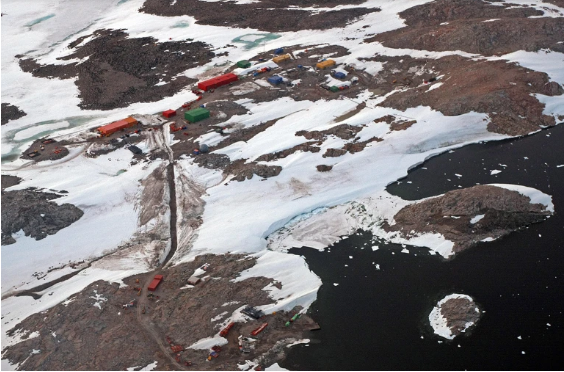
The sea floor near Australia’s Casey station in Antarctica has been found to have levels of pollution comparable to those in Rio de Janeiro’s harbor. Credit: Torsten Blackwood/AFP via Getty
Topics: Antarctica, Biology, Chemistry, Environment, Physics, Research
Antarctica is often described as one of the most pristine places in the world, but it has a dirty secret. Parts of the sea floor near Australia’s Casey research station are as polluted as the harbor in Rio de Janeiro, Brazil, according to a study published in PLoS ONE in August.
The contamination is likely to be widespread across Antarctica’s older research stations, says study co-author Jonathan Stark, a marine ecologist at the Australian Antarctic Division in Hobart. “These contaminants accumulate over long time frames and don’t just go away,” he says.
Stark and his colleagues found high concentrations of hydrocarbons — compounds found in fuels — and heavy metals, such as lead, copper, and zinc. Many of the samples were also loaded with polychlorinated biphenyls, highly carcinogenic chemical compounds that were common before their international ban in 2001.
When the researchers compared some of the samples with data from the World Harbor Project — an international collaboration that tracks large urban waterways — they found that lead, copper, and zinc levels in some cases were similar to those seen in parts of Sydney Harbour and Rio de Janeiro over the past two decades.
Widespread pollution
The problem of pollution is not unique to Casey station, says Ceisha Poirot, manager of policy, environment, and safety at Antarctica New Zealand in Christchurch. “All national programs are dealing with this issue,” she says. At New Zealand’s Scott Base — which is being redeveloped — contamination left from past fuel spills and poor waste management has been detected in soil and marine sediments. More of this historical pollution will emerge as the climate warms, says Poirot. “Things that were once frozen in the soil are now becoming more mobile,” she says.
Most of Antarctica’s contamination is due to historically poor waste management. In the old days, waste was often just dumped a small distance from research stations, says Terence Palmer, a marine scientist at Texas A&M University–Corpus Christi.
Research stations started to get serious about cleaning up their act in 1991. In that year, an international agreement known as the Protocol on Environmental Protection to the Antarctic Treaty, or the Madrid Protocol, was adopted. This designated Antarctica as a “natural reserve, devoted to peace and science,” and directed nations to monitor environmental impacts related to their activities. But much of the damage had already been done — roughly two-thirds of Antarctic research stations were built before 1991.
Antarctic research stations have polluted a pristine wilderness, Gemma Conroy, Nature.
